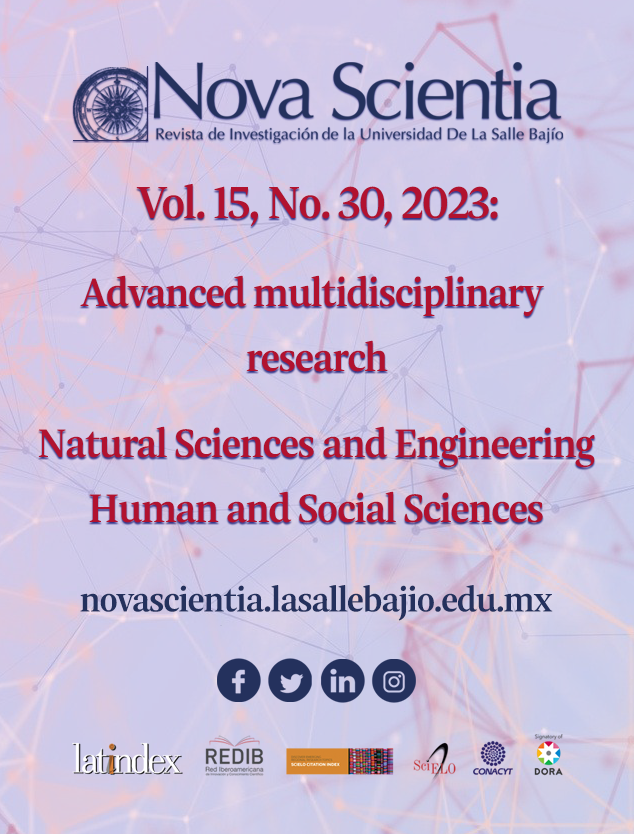Design, manufacture, and control motion of cartesian robot prototype with 5-DOF robot arm for possible spinning applications at laboratory-level
DOI:
https://doi.org/10.21640/ns.v15i30.3209Keywords:
cartesian robot , robot arm, designs, manufacture, control, prototypes, mechatronic systems , motors, electronic elements, control algorithmsAbstract
This document presents the development of a prototype of a Cartesian robot with a 5 degrees-of-freedom articulated robot arm for possible applications in a wet spinning process at the laboratory-level. The mechatronic system was developed using various modular electronics elements compatible with an ArduinoTM Mega 2560 microcontroller. The control algorithm recognizes the position of the servomotors and the speed of the motors so that the prototype performs a complete cycle of displacement in 67 s, which includes the transport of a polymeric filament immersed in a coagulation bath for 10 s. A structural analysis indicates that there will be no tension failures because the maximum and axial stress of the Cartesian robot was 2.89 MPa while the von Mises tension of the robotic arm was 468 MPa, both tensions below their upper limits. The pulse signals, in the order of 4000 +25 ms, of the servomotors were consistent in 96-98% repeatability and 3-19% reproducibility. Forty percent of the extrusion tests performed were satisfactory, since the transport of a polymeric filament within a coagulant solution was achieved.
Downloads
References
Dena-Aguilar, J. A., Jáuregui-Rincon, J, Bonilla-Petriciolet, A., Medina-Ramírez, I. E. & Romero-García, J. (2011). Graft copolymerization of poly(acrylonitrile) and vinyl acetate on starch via free radical in solution: synthesis and characterization. Afinidad, 68 (553), 195-202.
Dena-Aguilar, J. A., Zacarías-Moreno, E, Acevedo-Martínez, J., García-Vargas, F. & Moreno-Paredes, J. G. (2018). Diseño y construcción de un sistema de extrusión en frio de bajo volumen para la obtención de fibras poliméricas. Reporte técnico, Autor.
Fleischer, H., Drews, R. R., Janson, J., Patlolla, B. R. C., Chu, X., Klos, M. & Thurow, K. (2016). Application of a Dual-Arm robot in complex sample preparation and measurement processes. Journal of Laboratory Automation, 21(5), 671-681, doi: 10.1177/2211068216637352
He, Y., Du, E., Zhou, X., Zhou, J., He, Y., Ye, Y., Wang, J., Tang, B. & Wang, X. (2020). Wet-spinning of fluorescent fibers based on gold nanoclusters-loaded alginate for sensing of heavy metal ions and anti-counterfeiting. Spectrochim. Acta A Mol. Biomol. Spectrosc., 230, 118031. doi: https://doi.org/10.1016/j.saa.2020.118031
Käfferlein, H. U., Ferstl, C., Burkhart-Reichl, A., Hennebrüder, K., Drexler, H., Brüning, T. & Angerer, J. (2005). The use of biomarkers of exposure of N,N-dimethylformamide in health risk assessment and occupational hygiene in the polyacrylic fibre industry. Occup. Environ. Med., 62(5), 330-336. doi: http://dx.doi.org/10.1136/oem.2004.017129
Minati, L., Yoshimura, N. & Koike, Y. (2016). Hybrid Control of a Vision-Guided Robot Arm by EOG, EMG, EEG Biosignals and Head Movement Acquired via a Consumer-Grade Wearable Device. IEEE Access, 4, 9528-9541. doi: 10.1109/ACCESS.2017.2647851
Pomberger, A., Jose, N., Walz, D., Meissner, J., Holze, C., Kopczynski, M., Müller-Bischof, P. & Lapkin, A.A. (2023). Automated pH Adjustment Driven by Robotic Workflows and Active Machine Learning. Chemical Engineering Journal, 451 (part 4), 2023, 139099, https://doi.org/10.1016/j.cej.2022.139099
Rahul, K., Raheman, H. & Paradkar, V. (2020). Design of a 4 DOF parallel robot arm and the firmware implementation on embedded system to transplant pot seedlings. Artificial Intelligence in Agriculture, 4, 172-183. doi: https://doi.org/10.1016/j.aiia.2020.09.003
Sepúlveda, D., Fernández, R., Navas, E., Armada, M. & González-De-Santos, P. (2020). Robotic Aubergine Harvesting Using Dual-Arm Manipulation. IEEE Access, 8, 121889-121904. doi: 10.1109/ACCESS.2020.3006919
Shah, R. & Pandey, A. B. (2018). Concept for Automated Sorting Robotic Arm. Procedia Manufacturing, 20, 400-405. doi: https://doi.org/10.1016/j.promfg.2018.02.058
Siemasz, A., Tomczuk, K. & Malecha, Z. (2020). 3D printed robotic arm with elements of artificial intelligence. Proceeds Computer Science, 176, 3741-3750. doi: https://doi.org/10.1016/j.procs.2020.09.013
Tuntivivat, S. & Prempraneerach, P. (2011). Design and Construction and Motion Control of 6-Axis Robot Manipulator for Industrial Applications. The Second TSME International Conference on Mechanical Engineering, Krabi, Thailand, 19-21 October.
Yang, H.-S., Kim, Y.-M., Choi, H., Jang, J., Youk, J. H., Lee, B.-S. & Yu, W.-R. (2020). Electrochemical wet-spinning process for fabricating strong PAN fibers via an in situ induced plasticizing effect. Polymer, 202, 122641. doi: https://doi.org/10.1016/j.polymer.2020.122641
Ye, H., Wang, J., Shi, J., Du, J., Zhou, Y., Huang, M. & Sun, B. (2021). Automatic and Intelligent Technologies of Solid-State Fermentation Process of Baijiu Production: Applications, Challenges, and Prospects. Foods, 10, 680. doi: https://doi.org/10.3390/foods10030680
Yun, Y., Lee, S. J. & Kang, S. (2020). Motion Recognition-Based Robot Arm Control System Using Head Mounted Display. IEEE Access, 8, 15017-15026. doi: 10.1109/ ACCESS.2020.2964801
Zhang, B., Lu, C., Liu, Y., Zhou, P., Yu, Z. & Yuan, S. (2019). Wet spun polyacrylonitrile-based hollow-mesoporous fibers with different draw ratios. Polymer, 179, 121618. doi: https://doi.org/10.1016/j.polymer.2019.121618
Downloads
Published
How to Cite
Issue
Section
License
Copyright (c) 2023 Nova Scientia

This work is licensed under a Creative Commons Attribution-NonCommercial 4.0 International License.
Conditions for the freedom of publication: the journal, due to its scientific nature, must not have political or institutional undertones to groups that are foreign to the original objective of the same, or its mission, so that there is no censorship derived from the rigorous ruling process.
Due to this, the contents of the articles will be the responsibility of the authors, and once published, the considerations made to the same will be sent to the authors so that they resolve any possible controversies regarding their work.
The complete or partial reproduction of the work is authorized as long as the source is cited.



